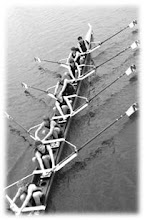by Marjorie T Hagerman
Practically speaking, how does one get the recommended 60% of total calorie intake as carbohydrate? Since a normal diet provides about 50-55% of calories as carbohydrate at best, food selection for a rower has to change to facilitate a good training diet. Foods supplying a high level of nutritious carbohydrate need to be increased; these include breads, cereals, pastas, fruits and vegetables, dried beans and peas and dairy products made from skimmed milk. Instead of the recommended four daily servings each from the high carbohydrate containing fruit/vegetable and bread/cereal groups, an athlete should have eight servings from each of these groups to continually replenish glycogen stores which are consumed during training efforts. Also, it's wise to have some of the fourteen weekly servings from the protein rich meat/fish/poultry/nut group provided by legumes - kidney beans, butter beans and soya beans, peas and dried peas, and lentils; these inexpensive foods not only provide a source of almost fat free protein, they are also high in carbohydrate.
Many rowers believe that eating toast and cereal for breakfast and a plate of spaghetti for dinner translates into a high carbohydrate diet but this is not necessarily so. Although grain products certainly are an important part of a high carbohydrate diet, one must also include generous amounts of fruits, fruit juices and vegetables, and at least two to three servings of low fat milk products daily. Remember, in order to keep the carbohydrate intake high, and the protein level adequate, the only expendable item in the diet is fat. In summary, a rower would want to plan his/her diet around the following foods:
Breakfast
- Cereal, toast, bagels
- Fruit and fruit juices, fruit smoothies
- Eggs (poached are prepared without added fat and are therefore preferred); limit to 3 to 5 per week
- Low fat yogurt or soft cheese
- Skim or low fat milk
Lunch and Dinner
- Low fat soup
- Salads with low fat or vingerette dressings
- Vegetables of all kinds (particularly beans)
- Lean meat, fish, poultry; skinless and steamed or roasted rather than deep-fried
- Bread,rolls,bagels
- Fresh or tinned fruit in unsweetened juice
- Low fat frozen yogurt, sorbet (other desserts limited to 2 to 3 times per week only)
- Skim or low fat milk
- Granola bars, power bars
- PB&J sandwiches
- Fresh or dried fruits and fruit juices
- Fig bars, oatmeal cookies
Athletes often wonder about the wisdom of including sweets as a part of their high carbohydrate training diet. From a standpoint of glycogen replacement, in the first 24 hours following an event, carbohydrate from simple sugars has a slight edge over starch carbohydrate in replenishing muscle glycogen. However, during the following 48 hours, starch carbohydrate is preferable for optimal glycogen stores. The practical suggestion is to include a mixture of carbohydrates, with concentrated sweet foodstuffs (biscuits, sweets, cakes, sweet desserts) eaten only in limited amounts, since they are also frequently high in fat and don't come packaged with as many other valuable vitamins and minerals (folic acid and iron, for example) as do carbohydrates from grains, fruits, vegetables and legumes.
Courtesy of Concept2

No comments:
Post a Comment